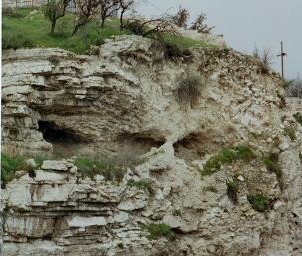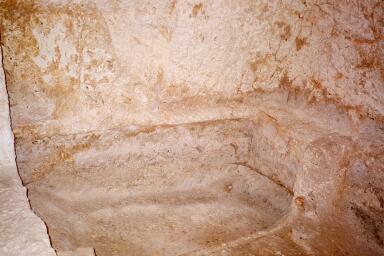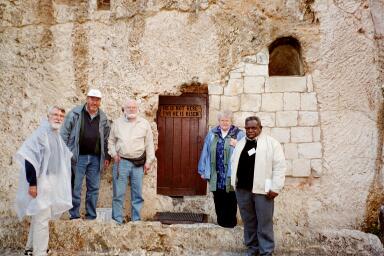Garden Tomb - He is Risen!
Reading: Luke 24.1-8
 In 1883 General Charles Gordon was on service in the Middle East. He was unsatisfied with the Church of the Holy Sepulchre as the site of Golgotha, believing that it couldnít be the actual place where the crucifixion and burial of Jesus had taken place.
In 1883 General Charles Gordon was on service in the Middle East. He was unsatisfied with the Church of the Holy Sepulchre as the site of Golgotha, believing that it couldnít be the actual place where the crucifixion and burial of Jesus had taken place.
One day he saw a rock formation which seemed to match the description of "the place called the Skull" (Luke 23.33). Excavating in the vicinity he came across some ancient tombs and concluded that he had indeed found the true site.
The land was bought by British interests in the early 1900s and it is a British guide who presents to visitors the credibility of the site. Although archaeology doesnít agree with Gordon (dating the tomb some four hundred years later), "the Garden Tomb" does have appeal for those who want the "feel" of what it was like. One Catholic priest is reported to have said that "if the Garden Tomb isnít the true site of the Lordís death and resurrection it should have been."
 The skull-like formation is right next to a modern bus station Ė perhaps there is something symbolic in that too! The Romans always chose a very public place for crucifixions Ė to make an example to all their subjects. Here, however, most of the crowd seemed to be against the condemned man. Even so, "When all the people who had gathered to witness this sight saw what took place, they beat their breasts and went away" (v. 48).
The skull-like formation is right next to a modern bus station Ė perhaps there is something symbolic in that too! The Romans always chose a very public place for crucifixions Ė to make an example to all their subjects. Here, however, most of the crowd seemed to be against the condemned man. Even so, "When all the people who had gathered to witness this sight saw what took place, they beat their breasts and went away" (v. 48).
"At the place where Jesus was crucified, there was a garden, and in the garden a new tomb, in which no one had ever been laid" (John 19.41). Joseph of Arimathea, a good and upright man who had disagreed with the Council, had the body of Jesus placed in this tomb.
The Garden Tomb is divided into two. One side was for mourners. On the other side was space for three burials. The stone slabs on which the bodies would have been laid are long since gone.
 The doorway is enlarged and there is no stone to close it. For security reasons a wooden door now closes the tomb when the area is closed at night. The door carries the words, "He is not here for he is risen."
The doorway is enlarged and there is no stone to close it. For security reasons a wooden door now closes the tomb when the area is closed at night. The door carries the words, "He is not here for he is risen."
On the first day of the week, women came with spices to the tomb. The stone was rolled away and the body gone. Two men in bright clothes announced to them, "Why are you looking for the living among the dead? He is not here; he has risen!" (Luke 24.5-6).
Thatís it! Thatís the important, mind-blowing, life-changing truth! You donít go to Israel and any of its sacred sites to find Jesus. He isnít a dead hero from the past. He is risen! alive! right here with us as he promised!
He truly came. What is recorded of him is historical fact. But we can receive him and trust him right where we are. Thatís the Easter joy! Thatís the joy and peace to strengthen us day by day.
| PRAYER: Jesus, you came. You lived and died. But you are alive, no longer restricted to time and place. We trust you as our Saviour and acknowledge you as our Lord. Enable us to live day by day in the knowledge of your presence and grace. Help us to convey love and hope to all we meet. In your name we pray, Amen. |
He is Risen!
In love
he came
to rescue
a world
gone wrong,
sinful,
self-centred,
autonomous.
In love
he lived
and taught
and healed.
In anger
and jealousy
they nailed him
to a cross -
cruel,
vengeful.
In love
friends laid his body
in a tomb -
bewildered,
grieving,
confused,
for they had hoped,
had trusted
in him.
But heís alive!
The tomb is empty!
Heís not among the dead!
Heís my Saviour,
Lord
and Friend!
© Peter J. Blackburn, 2001
More photos of Israel are available here.
Except where otherwise noted, Scripture quotations
are from the New International Version, © International
Bible Society, 1984.
Back to Sermons
 The skull-like formation is right next to a modern bus station Ė perhaps there is something symbolic in that too! The Romans always chose a very public place for crucifixions Ė to make an example to all their subjects. Here, however, most of the crowd seemed to be against the condemned man. Even so, "When all the people who had gathered to witness this sight saw what took place, they beat their breasts and went away" (v. 48).
The skull-like formation is right next to a modern bus station Ė perhaps there is something symbolic in that too! The Romans always chose a very public place for crucifixions Ė to make an example to all their subjects. Here, however, most of the crowd seemed to be against the condemned man. Even so, "When all the people who had gathered to witness this sight saw what took place, they beat their breasts and went away" (v. 48). In 1883 General Charles Gordon was on service in the Middle East. He was unsatisfied with the Church of the Holy Sepulchre as the site of Golgotha, believing that it couldnít be the actual place where the crucifixion and burial of Jesus had taken place.
In 1883 General Charles Gordon was on service in the Middle East. He was unsatisfied with the Church of the Holy Sepulchre as the site of Golgotha, believing that it couldnít be the actual place where the crucifixion and burial of Jesus had taken place. The doorway is enlarged and there is no stone to close it. For security reasons a wooden door now closes the tomb when the area is closed at night. The door carries the words, "He is not here for he is risen."
The doorway is enlarged and there is no stone to close it. For security reasons a wooden door now closes the tomb when the area is closed at night. The door carries the words, "He is not here for he is risen."